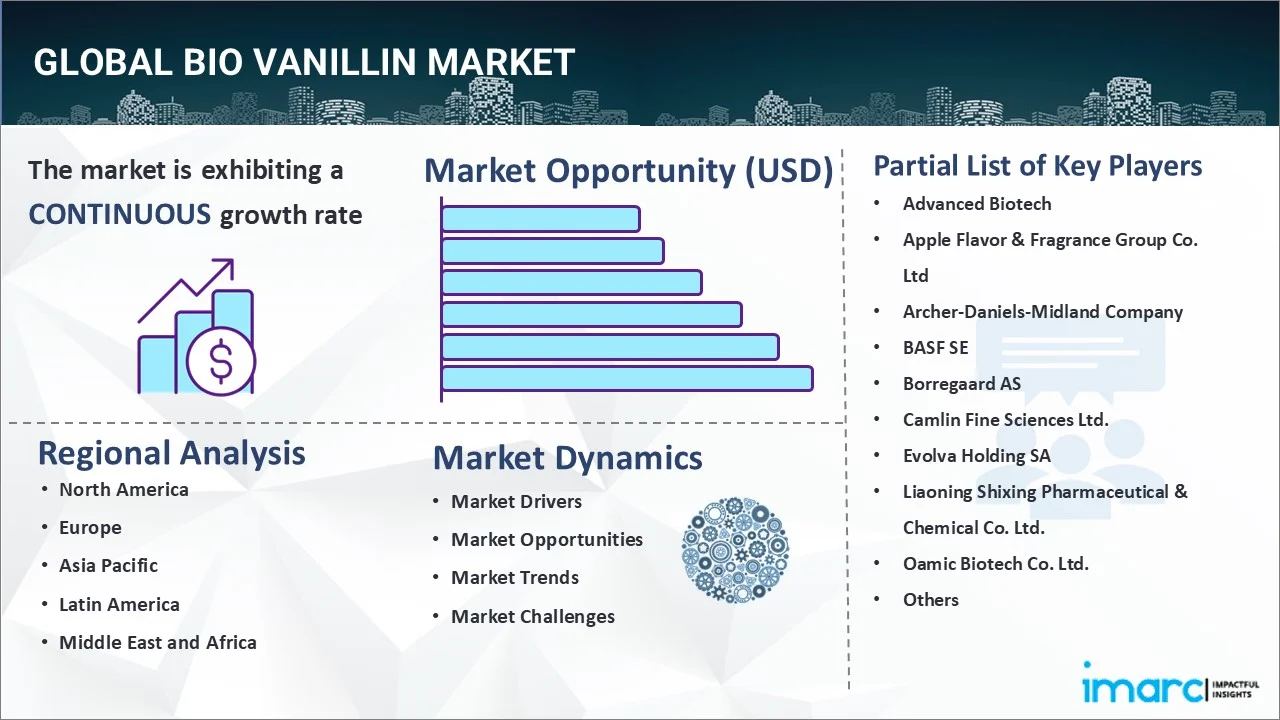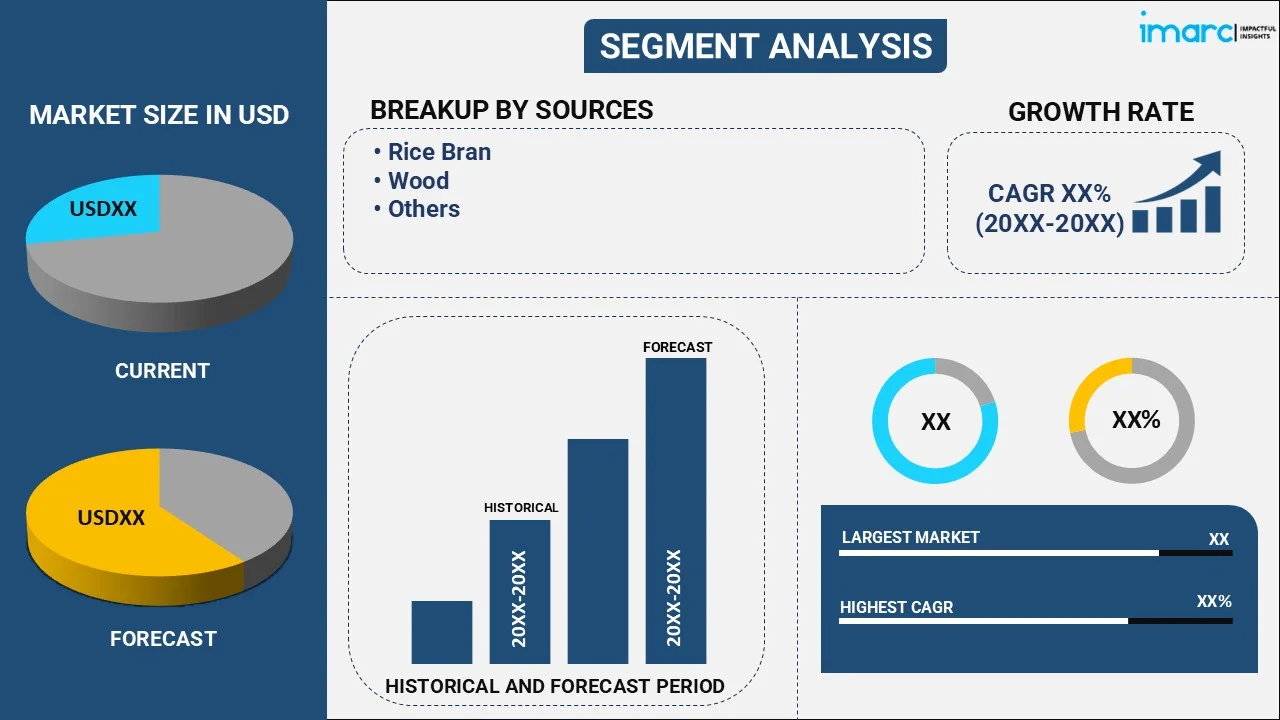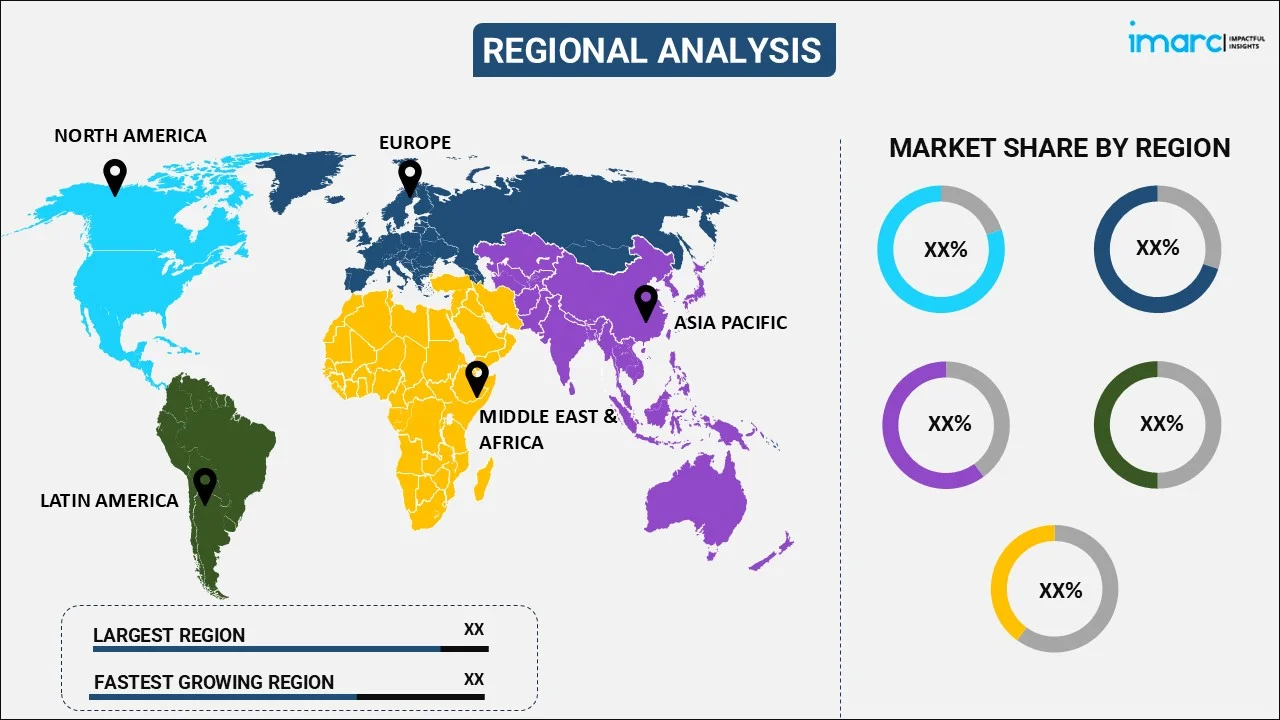
Bio Vanillin Market Report by Source (Rice Bran, Wood, and Others), Application (Food and Beverages, Pharmaceutical, Fragrance, and Others), and Region 2025-2033
Market Overview:
The global bio vanillin market size reached USD 202.9 Million in 2024. Looking forward, IMARC Group expects the market to reach USD 350.7 Million by 2033, exhibiting a growth rate (CAGR) of 5.95% during 2025-2033. The growing demand for natural and clean label ingredients among individuals across the globe, rising concerns about the environment and sustainability, and stringent rules and regulations to avoid the usage of synthetic vanillin are some of the major factors propelling the market.
|
Report Attribute
|
Key Statistics
|
|---|---|
|
Base Year
|
2024
|
|
Forecast Years
|
2025-2033
|
|
Historical Years
|
2019-2024
|
| Market Size in 2024 | USD 202.9 Million |
| Market Forecast in 2033 | USD 350.7 Million |
| Market Growth Rate 2025-2033 | 5.95% |
Bio vanillin, also known as natural vanillin, is a flavor compound that is derived from natural sources, such as wheat, rice, tea leaves, plants, and vegetables. It is a natural and sustainable alternative for flavoring various products while reducing reliance on non-renewable resource, and minimizing the environmental impact as compared to traditional vanillin production methods. Besides this, it assists in lowering the risk of various chronic diseases among individuals. As a result, it is widely employed in the pharmaceutical, food and beverage (F&B), and cosmetic industries across the globe.

At present, the rising utilization of bio vanillin in the food and beverage (F&B) industry for flavoring beverages and confectionery, bakery, and dairy items is strengthening the growth of the market. In line with this, the increasing preference for organic products, as they are free from chemicals and do not cause any harm to the body, is contributing to the growth of the market. Apart from this, the growing demand for bio vanillin due to the rising consumer awareness about natural and sustainable ingredients is positively influencing the market. In addition, technological advancements in bioconversion processes, extraction techniques, and biotechnology to improve the efficiency and scalability of bio vanillin production are bolstering the growth of the market. Furthermore, the rising utilization of bio vanillin in the perfume industry on account of the increasing demand for eco-friendly scents among individuals is supporting the growth of the market.
Bio Vanillin Market Trends/Drivers:
Rising demand for natural and clean label ingredients
There is a rise in the demand for natural and clean label ingredients among the masses around the world. Bio vanillin is a natural product that is widely utilized in various industries and reduces the risk of various side effects on individuals. It is also a clean label product as compared to synthetic vanillin and offers the same aromatic profile and flavor characteristics. Consumers are becoming more health-conscious and are actively seeking products with natural flavors and fewer artificial additives. Apart from this, there is a rise in the demand for natural ingredients and flavors in the food and beverage (F&B) industry due to the increasing awareness among consumers.
Increasing concern about the environment and sustainability
People are increasingly preferring bio vanillin, as it lowers the dependency on non-renewable resources and minimizes carbon emissions. There is a rise in awareness and concern about sustainability and environmental impact among the masses across the globe. In addition, consumers and businesses are choosing sustainable and eco-friendly alternatives and becoming more conscious of their ecological footprint, which is positively influencing the market. Bio vanillin is produced through a bioconversion process by using renewable feedstocks, such as ferulic acid or lignin, that offers a sustainable solution as compared to the petrochemical-based synthesis of synthetic vanillin. Furthermore, manufacturers are rapidly using bio-based ingredients to reduce the environmental impact and promote sustainability goals.
Stringent rules and regulations to avoid the usage of synthetic vanillin
Governing agencies of various countries are encouraging the adoption of natural products by implementing stringent rules and regulations on synthetic vanillin, which is contributing to the growth of the market. They are also imposing stricter guidelines on the use of synthetic additives, such as vanillin, in food and beverages. In addition, these regulations assist in ensuring consumer safety and promoting the use of natural ingredients. Food and beverage manufacturers are rapidly utilizing alternatives, such as bio vanillin, to comply with these regulations and enhance consumer experience. Apart from this, there is a rise in the preference for natural flavors as compared to synthetic additives among the masses across the globe.
Bio Vanillin Industry Segmentation:
IMARC Group provides an analysis of the key trends in each segment of the global bio vanillin market report, along with forecasts at the global, regional and country levels from 2025-2033. Our report has categorized the market based on source and application.
Breakup by Source:

- Rice Bran
- Wood
- Others
The report has provided a detailed breakup and analysis of the market based on the source. This includes rice bran, wood, and others.
Rice bran comprises ferulic acid, that is mainly used for bio vanillin production through bioconversion processes. In line with this, the rising demand for bio vanillin sourced from rice bran due to the wide availability of rice bran as a byproduct of rice milling is contributing to the growth of the market.
Wood is another essential source of bio vanillin as lignin is a complex organic polymer found in wood that can be extracted and converted into bio vanillin. In addition, the rising demand for wood, as it is an abundant resource and sustainable alternative, is propelling the growth of the market.
Others segments include additional sources of bio vanillin production, such as agricultural residues, biomass, and other plant-based materials. They comprise alternative feedstocks that can be utilized for bioconversion processes to produce bio vanillin.
Breakup by Application:
- Food and Beverages
- Pharmaceutical
- Fragrance
- Others
Food and beverages accounts for the majority of the market share
The report has provided a detailed breakup and analysis of the market based on the application. This includes food and beverages, pharmaceutical, fragrance, and others. According to the report, food and beverages represented the largest segment.
The rising product adoption in the food and beverage (F&B) industry as a flavoring agent in a wide range of food products is contributing to the growth of the market. Bio vanillin provides a natural and authentic vanilla flavor that assists in attracting a wide consumer base. Apart from this, manufacturers are increasingly using natural ingredients in numerous food and beverage items to cater to the demand of health-conscious consumers and improve the quality of the product. Furthermore, the rising demand for ready-to-eat (RTE) bakery products among the masses is bolstering the growth of the market.
Breakup by Region:

- North America
- United States
- Canada
- Asia-Pacific
- China
- Japan
- India
- South Korea
- Australia
- Indonesia
- Others
- Europe
- Germany
- France
- United Kingdom
- Italy
- Spain
- Russia
- Others
- Latin America
- Brazil
- Mexico
- Others
- Middle East and Africa
Asia Pacific exhibits a clear dominance, accounting for the largest bio vanillin market share
The report has also provided a comprehensive analysis of all the major regional markets, which include North America (the United States and Canada); Asia Pacific (China, Japan, India, South Korea, Australia, Indonesia, and others); Europe (Germany, France, the United Kingdom, Italy, Spain, Russia, and others); Latin America (Brazil, Mexico, and others); and the Middle East and Africa. According to the report, Asia Pacific accounted for the largest market share.
Asia Pacific held the biggest market share as it has abundant resources that serve as feedstock for bio vanillin production. Apart from this, the rising focus on sustainable and natural ingredients is contributing to the growth of the market in the region. In line with this, the growing demand for food products among individuals is offering a positive market outlook. Furthermore, the increasing utilization of organic and chemical free products among health-conscious individuals is supporting the growth of the market in Asia Pacific.
Competitive Landscape:
Key players in the industry are improving the production processes, increasing the efficiency of bioconversion, and enhancing the quality of the product. In addition, they are exploring innovative technologies and sustainable feedstock options to optimize production methods and reduce costs. Apart from this, major manufacturers are investing in infrastructure development by increasing the number of manufacturing facilities. They are also adopting advanced equipment and technologies to increase production efficiency. In line with this, companies are developing new formulations and customized solutions and incorporating bio vanillin into blends, extracts, and other flavoring ingredients to cater to the specific customer requirements. Furthermore, industry players are adopting eco-friendly practices and optimizing resource utilization to reduce carbon emissions.
The report has provided a comprehensive analysis of the competitive landscape in the market. Detailed profiles of all major companies have also been provided. Some of the key players in the market include:
- Advanced Biotech
- Apple Flavor & Fragrance Group Co. Ltd
- Archer-Daniels-Midland Company
- BASF SE
- Borregaard AS
- Camlin Fine Sciences Ltd.
- Evolva Holding SA
- Liaoning Shixing Pharmaceutical & Chemical Co. Ltd.
- Oamic Biotech Co. Ltd.
- Prinova Group LLC (Nagase America LLC)
- Solvay S.A.
- Sulzer Ltd.
- Symrise AG
Recent Developments:
- In July 2018, Archer-Daniels-Midland Company announced an agreement to acquire Rodelle Inc., a premium originator, processor and supplier of vanilla products to enhance the supply chain of the products.
- In 2020, Evolva Holding SA collaborated with International Flavors and Fragrances (IFF), a leading global creator of taste, scent, and nutrition for consumer products, to further develop and expand commercialization of vanillin.
- In September 2019, BASF SE acquired aroma biotech innovation leader Isobionics and partnered with Conagen, a leader in biotechnology research, to expand its portfolio with natural ingredients, such as vanillin, nootkatone and valencene.
Bio Vanillin Market Report Scope:
| Report Features | Details |
|---|---|
| Base Year of the Analysis | 2024 |
| Historical Period | 2019-2024 |
| Forecast Period | 2025-2033 |
| Units | Million USD |
| Scope of the Report | Exploration of Historical and Forecast Trends, Industry Catalysts and Challenges, Segment-Wise Historical and Predictive Market Assessment:
|
| Sources Covered | Rice Bran, Wood, Others |
| Applications Covered | Food and Beverages, Pharmaceutical, Fragrance, Others |
| Regions Covered | Asia Pacific, Europe, North America, Latin America, Middle East and Africa |
| Countries Covered | United States, Canada, Germany, France, United Kingdom, Italy, Spain, Russia, China, Japan, India, South Korea, Australia, Indonesia, Brazil, Mexico |
| Companies Covered | Advanced Biotech, Apple Flavor & Fragrance Group Co. Ltd, Archer-Daniels-Midland Company, BASF SE, Borregaard AS, Camlin Fine Sciences Ltd., Evolva Holding SA, Liaoning Shixing Pharmaceutical & Chemical Co. Ltd., Oamic Biotech Co. Ltd., Prinova Group LLC (Nagase America LLC), Solvay S.A., Sulzer Ltd., Symrise AG, etc. |
| Customization Scope | 10% Free Customization |
| Post-Sale Analyst Support | 10-12 Weeks |
| Delivery Format | PDF and Excel through Email (We can also provide the editable version of the report in PPT/Word format on special request) |
Key Benefits for Stakeholders:
- IMARC’s report offers a comprehensive quantitative analysis of various market segments, historical and current market trends, market forecasts, and dynamics of the bio vanillin market from 2019-2033.
- The research study provides the latest information on the market drivers, challenges, and opportunities in the global bio vanillin market.
- The study maps the leading, as well as the fastest-growing, regional markets. It further enables stakeholders to identify the key country-level markets within each region.
- Porter's five forces analysis assist stakeholders in assessing the impact of new entrants, competitive rivalry, supplier power, buyer power, and the threat of substitution. It helps stakeholders to analyze the level of competition within the bio vanillin industry and its attractiveness.
- Competitive landscape allows stakeholders to understand their competitive environment and provides an insight into the current positions of key players in the market.
Key Questions Answered in This Report
The bio vanillin market was valued at USD 202.9 Million in 2024.
We expect the global bio vanillin market to exhibit a CAGR of 5.95% during 2025-2033.
The rising consumer awareness towards the negative health impact of artificial flavors, along with the growing demand for bio vanillin as a natural flavoring agent to improve the aroma and shelf-life of various food products, is primarily driving the global bio vanillin market.
The sudden outbreak of the COVID-19 pandemic had led to the implementation of stringent lockdown regulations across several nations, resulting in the temporary closure of numerous end-use industries for bio vanillin.
Based on the application, the global bio vanillin market can be segmented into food and beverages, pharmaceutical, fragrance, and others. Currently, food and beverages hold the majority of the total market share.
On a regional level, the market has been classified into North America, Asia-Pacific, Europe, Latin America, and Middle East and Africa, where Asia-Pacific currently dominates the global market.
Some of the major players in the global bio vanillin market include Advanced Biotech, Apple Flavor & Fragrance Group Co. Ltd, Archer-Daniels-Midland Company, BASF SE, Borregaard AS, Camlin Fine Sciences Ltd., Evolva Holding SA, Liaoning Shixing Pharmaceutical & Chemical Co. Ltd., Oamic Biotech Co. Ltd., Prinova Group LLC (Nagase America LLC), Solvay S.A., Sulzer Ltd., and Symrise AG.
Need more help?
- Speak to our experienced analysts for insights on the current market scenarios.
- Include additional segments and countries to customize the report as per your requirement.
- Gain an unparalleled competitive advantage in your domain by understanding how to utilize the report and positively impacting your operations and revenue.
- For further assistance, please connect with our analysts.
 Inquire Before Buying
Inquire Before Buying
 Speak to an Analyst
Speak to an Analyst
 Request Brochure
Request Brochure
 Request Customization
Request Customization




.webp)




.webp)












